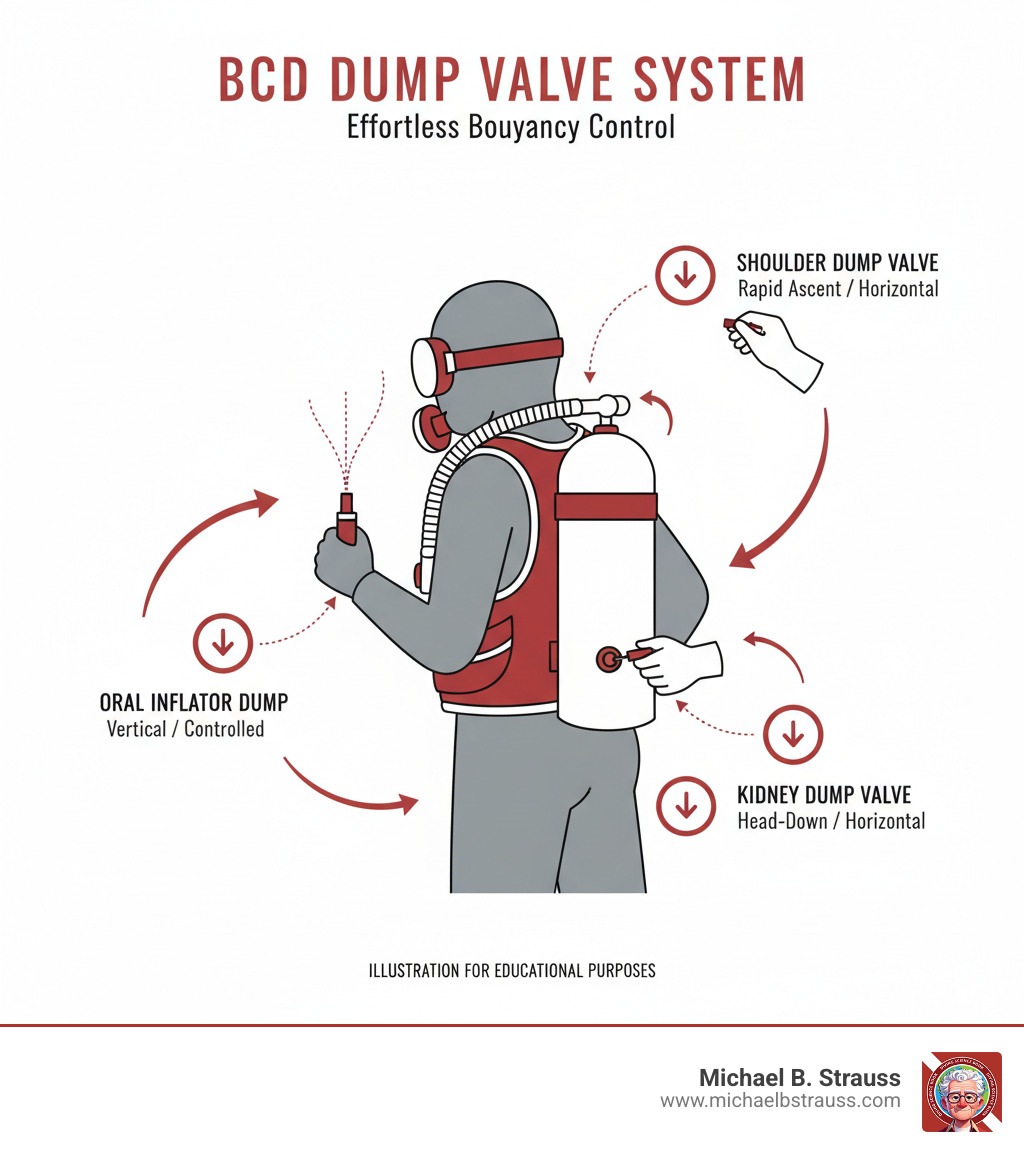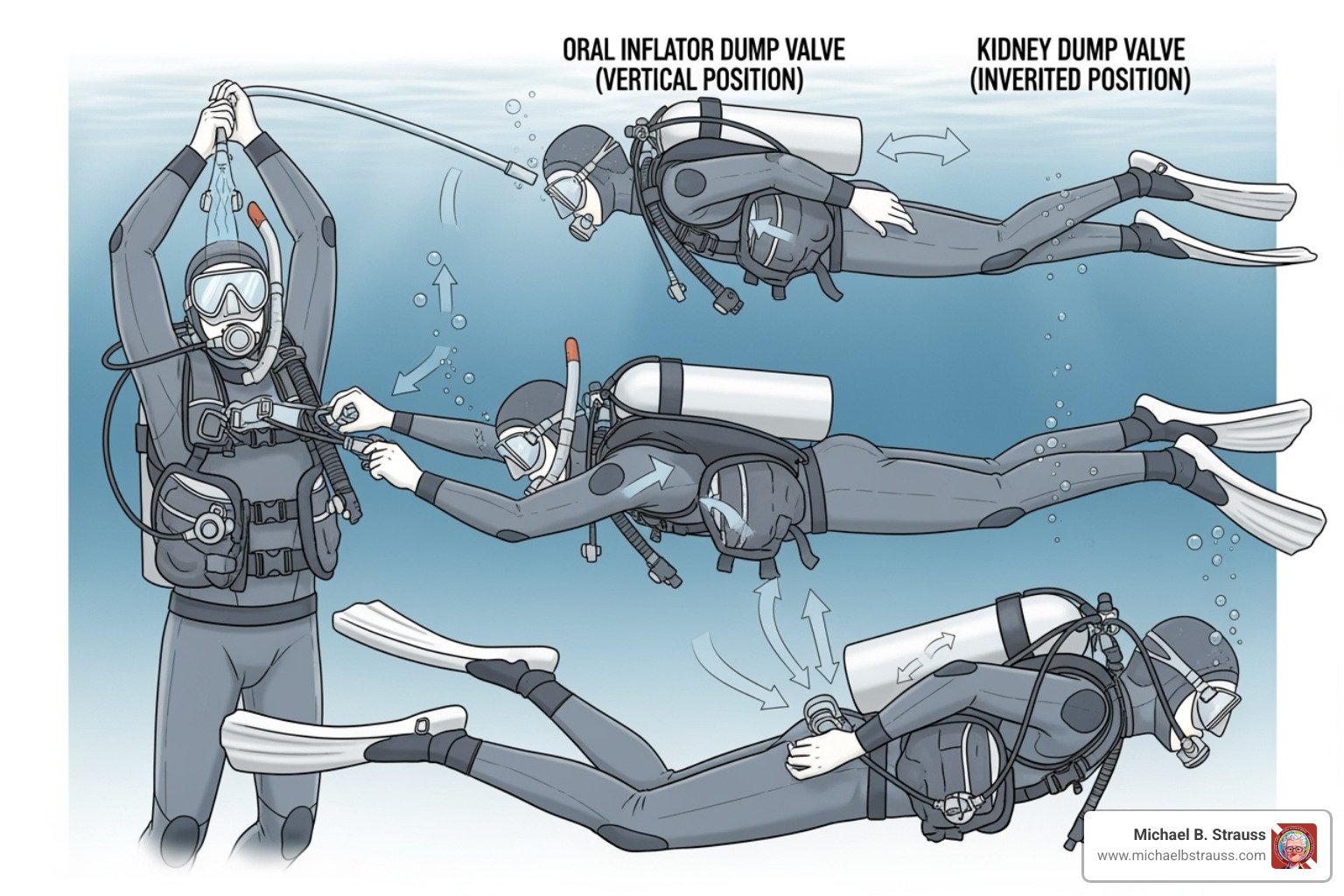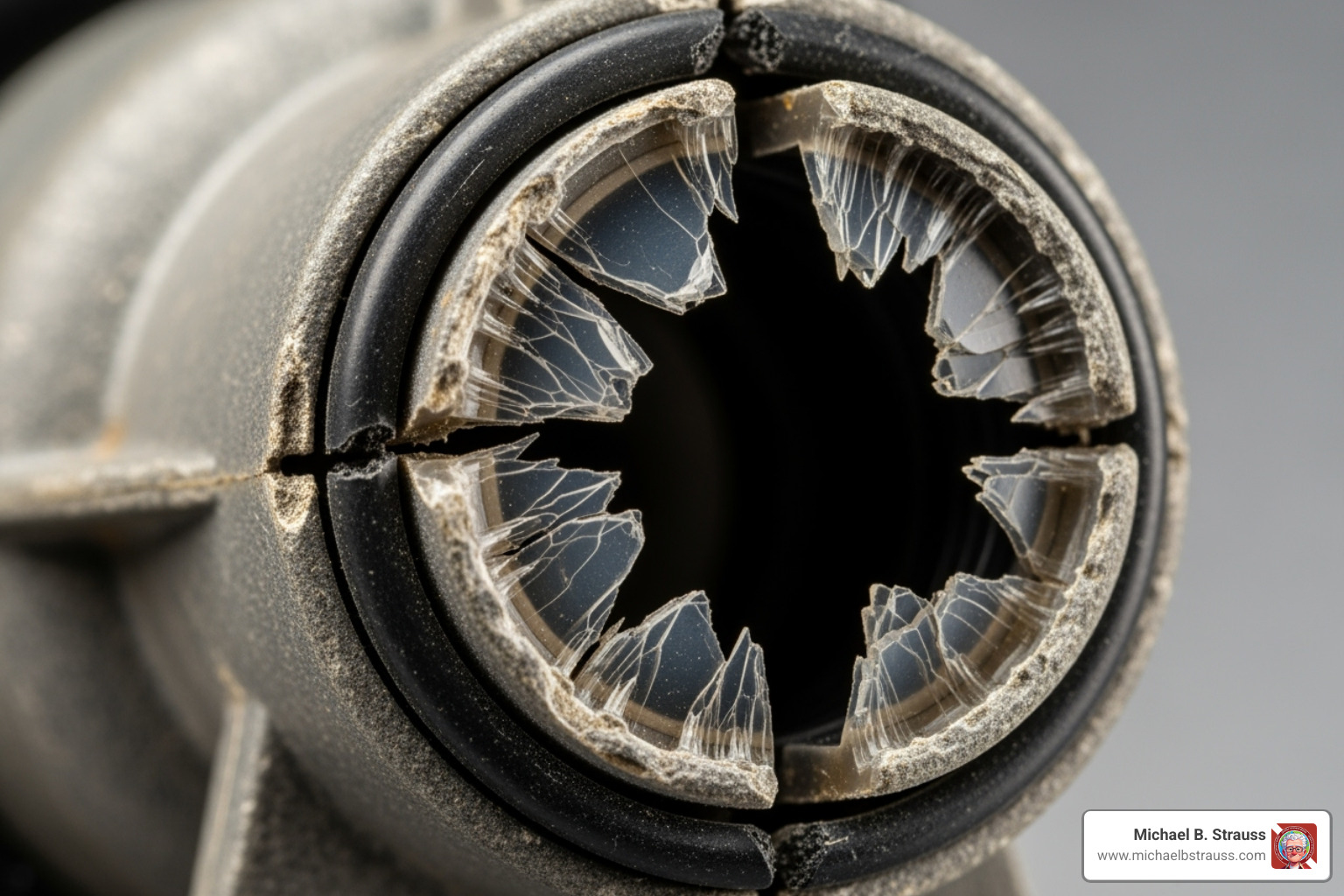Why Your BCD Dump Valve Could Save Your Life
A BCD dump valve is a critical safety feature that allows divers to quickly release air from their buoyancy control device (BCD). This controls ascent speed and helps maintain proper buoyancy. Understanding how to use these valves is essential for safe diving, as they are your primary means of deflation beyond the standard inflator hose.
Key BCD Dump Valve Types:
- Shoulder dump valve: Located on the shoulder, easily accessed with your right hand.
- Kidney dump valve: Positioned at the lower back, operated by reaching behind.
- Oral inflator dump valve: Built into the inflator mechanism on the corrugated hose.
Real-world incidents, like a valve coming apart due to age, highlight that knowing your BCD's deflation systems is about survival. Statistics from DAN (Divers Alert Network) confirm that buoyancy control failures are among the most life-threatening dive accidents. Still, many divers skip testing their dump valves during pre-dive checks, creating unnecessary risk.
Mastering BCD deflation means knowing when to use each valve, how to maintain them, and what to do if they fail. This knowledge is the foundation of confident and safe underwater navigation.

Mastering Your BCD Dump Valve: From Function to Failure
This section will explore the different types of dump valves, how to use them effectively, and what to do when things go wrong, ensuring you have the knowledge to maintain perfect buoyancy and handle any situation with calm and control.
The Anatomy of Buoyancy Control: Types of Dump Valves
A BCD dump valve, or Over Pressure Relief Valve (OPRV), lets air escape from your BCD, allowing you to descend, control your ascent, or fine-tune your position. Most BCDs have three main types:
- Oral Inflator Dump Valve: Integrated into the corrugated inflator hose, this valve is used to vent air by holding the hose high and pressing a button. It's easily accessible in a vertical position but less practical for maintaining a horizontal trim.
- Shoulder Dump Valve: Located on the BCD's shoulder (usually the right), this valve is operated by pulling a toggle. It's convenient for quick air release in an upright position, making it ideal for descents or safety stops.
- Kidney (or Rear) Dump Valve: Found on the lower back of the BCD, this valve is crucial for divers in a horizontal swimming position. Air collects at the highest point of the BCD—your back—making this the most effective valve for releasing air without changing your body orientation.

Each valve has its purpose. The oral inflator is versatile but requires vertical positioning, the shoulder dump is fast for upright adjustments, and the kidney dump excels at maintaining horizontal trim. Experienced divers learn to use the right valve for the situation.
In-Water Techniques: When and How to Dump Air
Knowing when to use your BCD dump valve versus the inflator hose deflator depends on your orientation in the water.
- During Descent: To become negatively buoyant, release air. In a vertical, feet-first descent, the oral inflator or shoulder dump valves are most convenient. For a horizontal or head-down descent, the kidney dump valve is more effective, as it allows you to release air without changing your streamlined position.
- Maintaining Buoyancy: While swimming horizontally, use the kidney dump valve for small adjustments. This lets you vent air without disrupting your trim, unlike using the shoulder or inflator hose dumps which can cause you to tilt.
- During Ascent: As you ascend, the air in your BCD expands. You must vent it to control your ascent rate. For controlled ascents and safety stops, the oral inflator or shoulder dumps work well in a vertical position. If you're in an unusual orientation, the kidney dump can still release air from the highest point of the BCD.
Developing muscle memory with all deflation options is key. While the inflator hose is a primary control, practicing with every dump valve makes your reactions instinctive. Mastering these techniques allows for effortless buoyancy control, letting you focus on the dive itself. For more on the physics behind these skills, explore resources on Diving Science.
Pre-Dive Checks and Emergency Procedures
A thorough pre-dive check of your BCD dump valves is a non-negotiable safety step. You and your buddy should check all methods of inflation and deflation.
Pre-Dive Valve Check:
- Inspect: Visually check all valves for cracks, wear, or loose connections. Ensure pull cords are intact.
- Inflate: Fully inflate the BCD and listen for leaks.
- Test: Actuate each dump valve (oral, shoulder, and kidney) one by one. Confirm that air releases steadily and that the valve seals completely when released.
- Tighten: Check that threaded valve connections are snug, as they can loosen over time.

Emergency Procedures for Valve Failure:A failed BCD dump valve is a serious issue. Stay calm, signal your buddy, and identify the problem.
- Valve Stuck Open (Losing Air): Continuously add air with your power inflator to maintain buoyancy. Try to manually close or block the leaking valve. If you can't control your buoyancy, begin a slow, controlled ascent. Dropping weights is a last resort.
- Valve Stuck Closed (Can't Release Air): Immediately use another dump valve to release air. If all valves fail, you can still vent air through the oral inflator hose. Begin a controlled ascent to avoid a rapid, uncontrolled rise.
Having multiple dump points provides crucial redundancy in an emergency.
Common BCD Dump Valve Failures and Safety
BCD dump valves can fail for several reasons. Common issues include:
- Material Degradation: Over time, exposure to saltwater and UV light can make plastic components brittle, leading to cracks or breakage.
- Detachment: Threaded valves can unscrew from the BCD bladder, causing a major leak. This is why pre-dive checks are so important.
- Leaking and Sticking: Aging seals can cause slow leaks, while debris or wear can cause a valve to stick open or closed.
The materials and design directly impact durability. Plastic parts are lightweight but can degrade, while internal springs and seals can weaken over time. The attachment mechanism (threaded, glued, or welded) also affects reliability.
A malfunctioning BCD dump valve has serious safety implications. A valve stuck open can cause an uncontrolled descent, while one stuck closed can lead to an uncontrolled ascent, increasing the risk of decompression sickness. Proper equipment function is critical for avoiding these scenarios, a key topic in Decompression Science.

Long-Term Care: Maintenance and Compatibility
Proper maintenance is essential for the longevity and safety of your BCD dump valves.
Maintenance Tips:
- Rinse Thoroughly: After every dive, rinse the entire BCD with fresh water, actuating each dump valve to flush out salt and debris.
- Rinse Internally: Periodically, pour fresh water inside the BCD bladder, slosh it around, and drain it through the dump valves to prevent internal buildup.
- Dry Properly: Air dry the BCD completely in a shaded area to prevent UV damage.
- Inspect Regularly: Periodically check for cracks, wear, and loose fittings.
- Get Professional Service: For any repairs or annual servicing, use an authorized professional. Improper service can be fatal.
Compatibility and RepairsA critical issue for divers is the lack of standardization for BCD parts between brands. A BCD dump valve from one manufacturer will almost certainly not fit a BCD from another. Even within the same brand, parts from different model years may be incompatible. This makes DIY repairs on critical components like dump valves extremely risky.
| Feature | Professional Servicing | DIY Repairs (for significant issues) |
|---|---|---|
| Expertise | Certified technicians with specialized training and tools | Limited knowledge, general tools |
| Part Compatibility | Access to genuine, compatible manufacturer parts | High risk of using incompatible parts; no standardization between brands |
| Warranty | Maintains warranty validity | Voids warranty |
| Safety | Ensures equipment meets safety standards | Risk of improper repair leading to equipment failure and injury/death |
| Cost | Initial cost higher | Appears cheaper, but potential for greater cost if repair fails or causes damage |
| Reliability | High | Low, especially for critical components |
Given that your BCD is life-support equipment, always use an authorized service center for repairs. This ensures your safety and the use of correct, compatible parts.
Expert Insights and Environmental Factors
Experienced divers and instructors offer key advice regarding BCD dump valves:
- Practice Redundancy: Your multiple dump valves are a redundant system. If one fails, you have backups. Practice using all of them until it's second nature.
- Use Proper Weighting: Correct weighting is fundamental to good buoyancy control. Being over-weighted forces you to constantly add and dump air, which is inefficient.
- Perform Buddy Checks: Ensure your buddy knows where your dump valves are and how to operate them in an emergency.
Environmental factors also affect valve operation. Cold water can reduce dexterity, making it harder to operate toggles, especially with thick gloves. Strong currents or low visibility make easy access to reliable dump valves even more critical. Understanding these factors helps you prepare for varied conditions. For an interesting perspective on buoyancy in nature, you can explore topics like Mammalian Divers.
Conclusion: Diving with Confidence
Mastering your BCD dump valve system transforms your diving from a mechanical exercise into an intuitive, fluid experience. This guide covered the three main valve types—oral inflator, shoulder, and kidney—and how to use each effectively to achieve perfect trim.
We've emphasized that pre-dive checks are your safety insurance, and regular maintenance like freshwater rinsing is crucial for reliability. Due to the lack of part standardization between brands, always rely on professional servicing for repairs.
Equipment can fail, but knowledge and calm preparation are your best tools for handling any situation. Understanding your BCD's deflation systems allows you to respond effectively to problems and dive with confidence.
Effortless buoyancy control lets you conserve air, protect marine environments, and fully immerse yourself in the wonder of the underwater world.
For those ready to dive deeper into the principles of safe diving, get your copy of the book Diving Science here: https://www.bestpub.com/view-all-products/product/diving-science-revisited/category_pathway-48.html
DISCLAIMER: Articles are for "EDUCATIONAL PURPOSES ONLY", not to be considered advice or recommendations.






